HOME | ABOUT US | MEDIA KIT | CONTACT US | INQUIRE
HOME | ABOUT US | MEDIA KIT | CONTACT US | INQUIRE
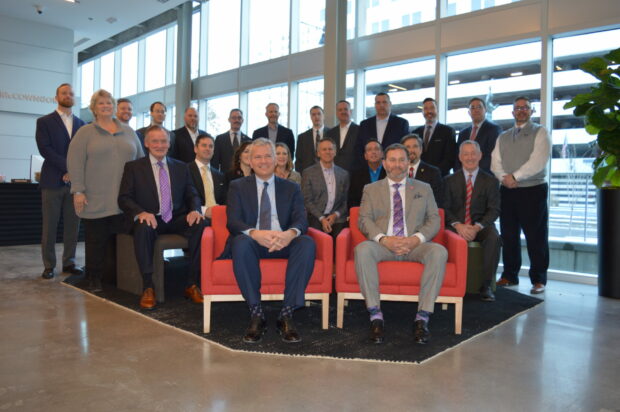
In an era of low margins but ample work, contractors in the Kansas City region are hustling more today than any time since the onset of the Great Recession nearly 15 years ago. But they do so amid sweeping change in the demographics of the work force (and skill sets of those workers), in technology and tools to improve productivity, and with increasing demands for shorter delivery cycles—all the while pressured by material costs and other factors. In other words, it’s busier than it has been in years, but the pressures are quite familiar to any construction-related executive. Two dozen of them gathered Dec. 19 at the spacious, sparkling new headquarters of McCownGordon Construction for the 2020 Construction Industry Outlook assembly to assess ways they and their peers are managing those challenges. Co-chaired by Steve Levy of the host firm and Steve Hancock of co-sponsor U.S. Engineering, they engaged in a spirited two-hour discussion that should yield guidance for anyone considering a career in construction, as well as anyone anticipating a construction project in 2020.
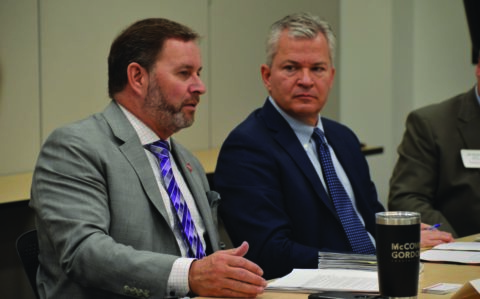
Steve Levy, left, and Steve Hancock directed a discussion that swiftly covered topics from safety, productivity, industry margins, technology, work-force challenges and more.
Priority One
When you hear about challenges confronting the construction sector, it’s often in the context of work-force depletion, embracing new technologies, managing narrow margins and the like. There’s little doubt, though, that foremost on the minds of contracting executives are workplace safety issues.
And for good reason. In 2018, more than 21 percent of the workplace fatalities in the U.S. occurred in construction settings, trailing only the transportation sector. Construction isn’t the most dangerous of jobs—logging and deep-sea fishing have those titles locked up—but safety is enough of an issue for builders that they have undergone sweeping cultural shifts to improve the collective image of the sector.
Executives at the assembly had plenty to say about how they’re addressing that critical issue.
“Like it or not, we’re still building buildings, that still takes time, and the work is still done by men and women who really are risking their lives,” said Mary McNamara, owner of Cornell Roofing. “I tell them, ‘I refuse to meet your spouse in the emergency room to tell them you’ve had an injury.’ I’ve been there. I don’t want to go back.”
And it’s precisely what Randy Bredar of JE Dunn Construction calls “the thing that keeps me up at night: the safety of the people on our job sites. We’re trying to instill that culture to be careful about everything.”
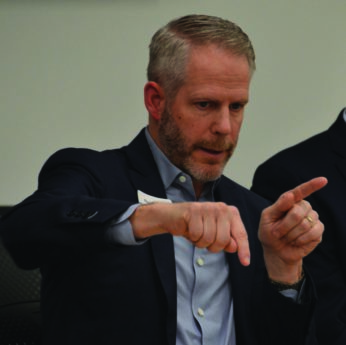
Paul Neidlein talked about the challenges of getting veteran employees fully on-board with an evolving safety culture.
“We are not building a car in a factory,” said Turner Construction’s Zach Loy, “and often, we’re not doing things in controlled environments—we are doing dynamic things in an ever-changing environment, and with that comes inherent risks.” Thus, he said, the challenge is to create a culture whereby the company is “not accepting anything above zero” with injury reports. “It’s about caring for one another, being our brothers’ and sisters’ keepers on the sites, and chang-
ing the culture and focus from top to bottom and back up.”
Despite concerted efforts to make safety Priority One, Pete Browne of Kissick Construction said, “We have a fabulous culture, but there are some guys and women who see it and some who just don’t get it.” He recalled lunch with one crew where an employee observed that, years ago, “we didn’t have safety.” “I said, ‘Yes, you did: You just didn’t think about it.’ We want everyone to be cognizant of it.”
That, Browne said, means accounting for process changes that ensure safety, and building them into project bids. “We’re great compared to 30 years ago, but none of us are there yet” with safety issues, he said.
IMA Corp.’s Mike Campo, with the perspective of a surety professional, seconded that. On average, he said, losses from workplace injuries were down 34 percent over the past 10 years. “It’s great improvement, but one person hurt is one too many,” Campo said.
David Harwood of the engineering firm Terracon sees safety as more than a workplace issue. “The challenge is employees who come in the door and flip a switch on safety,” Harwood said. “The practices they have at home are not the practices they have at work. How we drive those into their personal lives is that safety is not something that happens when you punch the clock, but when get in your car, get home, or go on vacation.”
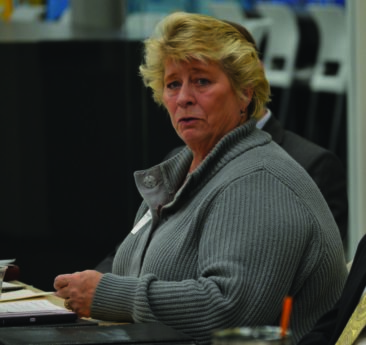
No bones about it: Mary McNamara promises swift disciplinary action for any employee who disregards her company’s safety protocols.
For Shawn Handy of Pinnacle Construction Group, the type of personality often found in blue-collar workers also plays a role—a great many aren’t the types to open up about things. “There are so many people with so many different impressions,” he said. “They keep everything bottled up. We all know that talking helps; they just need to get it out there.”
Perhaps no one gets it out there as emphatically as Mary McNamara. “When I came into the company, it lacked sufficient safety processes; that was immediately changed,” she said. “It’s about adopting a safety culture and then enforcing a safety culture. We can talk about it, but if you are not enforcing that commitment, and it doesn’t come from the top, it’s not going to change.”
She personally reviews all safety inspection reports, “and if I see that there is a violation, it’s kind of dictatorial, but that’s too bad. My immediate reaction is that the employee receives a 3-day suspension. He can go home to tell his family why he’s three days short on his paycheck. Too damn bad. If you’re going to behave in an unsafe manner, I’m going to respond.”
You can’t argue with the outcomes: “I’m not sure I had to send anyone home in 2019,” McNamara said.
At nuclear power plants, said Smitty Belcher, safety violators are escorted off the plant site. “Why is it not the same on the commercial side?” he asked, “I’ve been in that ER, too. I never want to do it again. I will fire you.”
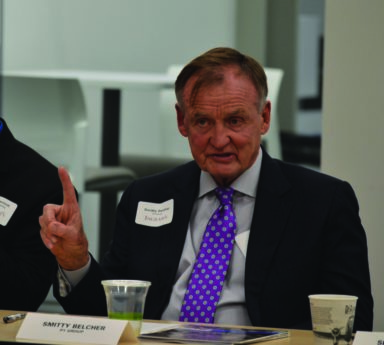
Smitty Belcher said issues with cybersecurity are the kind of thing that scares him.
Paul Neidlein sees the age splits in the work force as a key indicator, and the industry stats on fatal injuries back it up: The age group with the most incidents involved those 64 and older in the sector. “It’s harder to convince people who have been here longer,” he said. “They have every tool, the culture is there, and we’ve seen the rate of and severity of injuries go way down. But it’s that behavioral piece: How do we get people to think about it and take that home? That’s the hard part, how we change habits that have been there forever. But it has to be one person at a time, and you have to be hard.”
Making an example of offenders, said David Harwood, is a powerful tool. Unsafe behavior “is a risk to the rest of the employees in your organization. You put yourself at risk for new opportunities because of one bad character. Their example may influence somebody else to do something careless.”
A new era of safety consciousness, said Steve Levy, is actually grounded in subtle, long-term shifts. “When I was young and starting out, it was more about production—you went to work to get as much done as you could, and didn’t even think about getting home safely. Now, the work force, and especially the Millennials, they are expecting you to keep them safe. They have an expectation that 30 years ago, I don’t think the work force had. But you have to be more deliberate about it, and it can’t be just a policy or a process—it has to be part of the culture.”
Productivity
As it turns out, questions of productivity and safety are inherently intertwined. As, of course, are issues like compressed project delivery timetables, compensation, work-force recruiting and retention, razor-thin margins and other considerations.
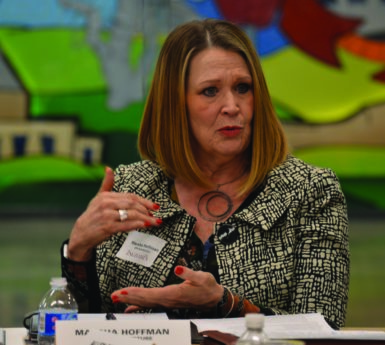
When the last downturn hit, SFS Architecture saw a lot of previously unknown players swerve into its lane, said Marsha Hoffman.
But the construction sector has chafed for years at the suggestion that it’s been mired in a productivity bog, unable to leverage new technologies and processes to keep pace with other blue-collar areas like manufacturing and even farming.
For the record, you will get an argument on that from these executives.
“I’ve been impressed with our productivity and its increase over the past 25 years,” said Pete Browne. “With some of the earthway activities, the tech is so much better, and our concrete work is better. Some activities are still very labor-intensive, but we pour concrete 12 months a year, and I see that productivity increase.”
Mary McNamara concurred, citing her everyday experience at sites to observe preparation and operations. “Twelve years ago, if there was snow on the ground, no one went to a job site to prep, but now we go to get it cleaned and done. But with the speed of construction we work under, we have to look at ways to increase productivity, whether it’s with mechanical equipment we can use on site, or find materials that may be more expensive, but are ready to be used on that project.”
Smitty Belcher pointed out that a few recalcitrant elements in the work force aren’t helping. “For us, it’s the acceptance of your field forces in modulation, fabrication and getting them to recognize the need to embrace that and get over the mindset you’re taking work away” by adopting new technologies, he said. “I think it’s a two-fold issue. Productivity may have stayed about the same, but at the same time, safety today is not what safety was years ago. You’re much more safety-conscious, and that affects productivity on a day-to-day basis.”
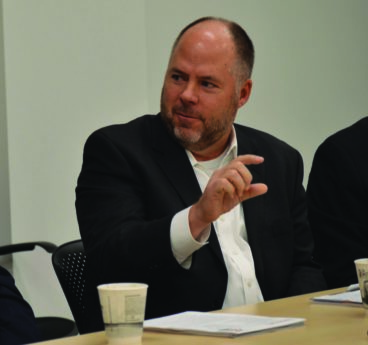
Greg Carlson addressed the role of modulization and prefabrication in terms of improved productivity.
“I think there’s been improvement in the way we deliver projects now,” said Paul Neidlein. “If you just look at concrete and waiting for it to turn hard, that hasn’t changed much. But we’re delivering things faster than ever before. Look at construction process from inception to completion; that’s where you have to look to see the true improvements. We’re building a custom car every time—that’s why those cars cost a lot more.”
One reason for productivity improvements, said Marsha Hoffman, is that “we’re heading off issues in the field much faster with our processes.” The complexity of projects is a layered challenge, she said, “and we’re trying to do more and more. Having people at the table early on helps with issues like costs.”
That, said Randy Bredar, is a key to fostering more efficiency. It requires a wider embrace of collaboration within and across organizations, from owner to designer to contractor and subs. “We try to have the right expertise at the table at the right time,” Bredar said. “None of us is as smart as all of us, so how do we get all of those people to the table first for the right decision-making?”
Those voices help, said Emily Tilgner, because “buildings are more complicated today, and collaboration can make for a more efficient process. ‘I may know how
to design this piece, but I don’t know how to put it together.’ That’s where we’re getting more efficient.”
Across the process, said Rick Oddo, “to me, the design is half the time it used to be. That has been fabulous to have. But you still can’t speed up some of the production processes. You just can’t.” Advances to quicken the pace of hanging drywall or install plumbing have helped, he said, “but with the basic industry, there are still man-hours you can’t computerize. Stick-building, roofing hasn’t changed all that much. But I guarantee you’re better off working with a contractor and design-build across the board.”

Pete Browne made a strong argument in favor of increased public spending on infrastructure, particularly with highway and transportation systems in Missouri and Kansas.
In some ways, Mike McKeen said, things are actually backtracking. He point-ed to a recent project on Metcalf Ave. in Overland Park, one that took as much time as the 200-unit work on Mission Farms a decade ago. “The exact same time window, only costs went from $75 a square foot to $125 a square foot,” he said, so it’s not changing the result for wood-frame construction. “It doesn’t benefit across the board” or otherwise impact the schedule, he said.
Burns & McDonnell attacks part of the productivity challenge, said Greg Carlson, by “trying to get as much modular work as we can and then get it from the warehouse to job site. We’re putting a safety component into that as well. What it boils down to is getting rid of waste and redundancy.” Still, he said, no matter how much prefabrication can be executed, it seems “the time frame is running out at the end of a project” in many cases, given the demands for quick delivery.
Meeting that challenge is tough, said Smitty Belcher, “because the systems are so much more complicated. You need time to get the systems to work the way they’re supposed to, and it seems like we always want to rush this.”
To robust and knowing laughter, Pete Browne summarized the owner-contractor dynamic thusly: “The first words I always hear,” he said, “are ‘Congratulations, you got the job—and by the way, you’re behind schedule.’”
Concerns Aplenty
The diversity of perspectives around the table prompted observations not just from contractors, but owners, design firms, surety interests and construction law specialists, and they offered a quick assessment of the mega-trends shaping
the industry today.
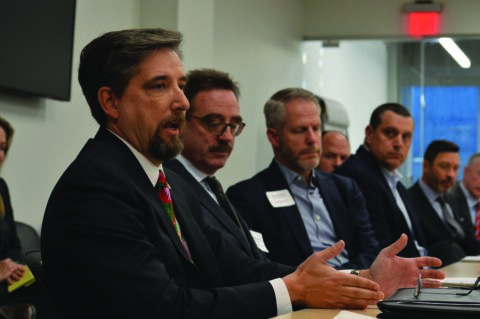
David Harwood said that employees who disregard safety processes do more organizational harm than putting just themselves at risk.
Jason Buchanan, a partner at the law firm of McDowell, Rice, Smith & Buchanan, said the biggest concern he hears from clients is “they are waiting with bated breath for Congress to pass the infrastructure bill, that’s something I hear all the time.” Clients, as well, are increasingly interested in finding ways to more quickly resolve smaller claims.
He also said that, given the fallout from consolidations after the Great Recession, “we are seeing a lot of legacy claims. Right after the period where a company is acquired and before being culturally acclimated to a new one, that is a period where liability is rising.”
From the developer/owner silo, Rick Oddo said his biggest concern “was getting things we need through City Councils.” Zoning, permitting and other regulatory issues are a constant challenge in his space, and have long been complicated by the multiple municipalities layered over a line dividing two states.
Others at the table expressed concerns that a new wave of civic leadership—on the Kansas City Council, in particular—lacked a fundamental appreciation for the benefits of development and the role played by the public sector to prime that growth pump.
Said Pete Browne: “I’m disappointed in the Missouri and Kansas commitments to infrastructure.” Missouri especially, he said, “has Third-World roads, bridges and utilities. If we’re going to sell our region to the world, we have to have a commitment to infrastructure from a state tax level,” and that commitment historically has yielded at least a six-fold ROI in terms of additional economic growth. “That lack of spending at MoDOT and KDOT, as well as building infrastructure—I think it has hurt our economy,” Browne said.
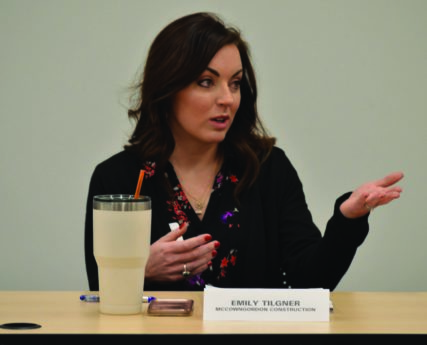
The furious pace of industry change is a daily concern, said Emily Tilgner.
Emily Tilgner cited the increasing pace of project work, driven by demands for shorter delivery times from owners. That tied into the surety concerns of IMA Corp.’s Mike Campo, who said he was paying attention to “the risk associated with the constant rate of change.” Those pressures extend to the leadership ranks, as well, noted U.S. Engineering’s Rob Marriott: “With the speed of the industry today, what concerns me is leadership burnout.”
Weather is always a consideration, and a frustrating one in that it alone defies human attempts to control or manage its impact. Jon Runyan said Luke Draily had a project coming up in Colorado, where weather would play an outsized role. That has a bottom-line impact, said Pete Browne, who noted that “in 2019, Mother Nature was not kind to us” at Kissick.
Lockton Companies’ Chuck Teter cited concerns about training for a new generation of workers, an issue closely linked to Greg Carlson’s observations about the prospects of latent construction defects: “I’m concerned about what happens five years from now with the lower skill levels working today,” he said.
Zach Loy said his sleep is interrupted by thoughts of “preparing the company for the inevitable market crash in the next couple of years,” while TitanBuilt’s chief executive, Scott Vath, shared similar concerns “about what the next downturn really looks like.”
Smitty Belcher offered cybersecurity as a lingering worry; “it scares me,” he said, and Mary McNamara pointed to new players emerging as competitors in the commercial roofing space; not all of them necessarily bring the competencies and reputation her 97-year-old firm has worked to build.
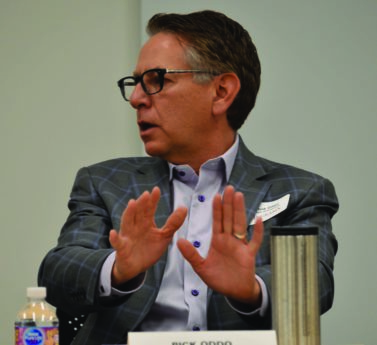
Rick Oddo addressed the difficulties that developers are having with fragmented zoning, approval and regulatory processes in the region.
Profitability
Of bottom-line issues, Paul Neidlein pointed to “the cost of construction outpacing inflation, the cost of capital, and trying to keep up with it,” while his colleague at JE Dunn, Randy Bredar, said pressures to secure bids, a hangover from the Great Recession’s imperative to secure work at nearly any cost, means “we can be our own worst enemy with one another.”
“This is what one surety told me they call a marginless recovery,” said Neidlein. “Margins have not gone up as fast during this recovery.”
To counter that, said Greg Carlson, Burns & McDonnell “has been able to be more selective. You’re getting rid of the marginal project and the higher-risk project.”
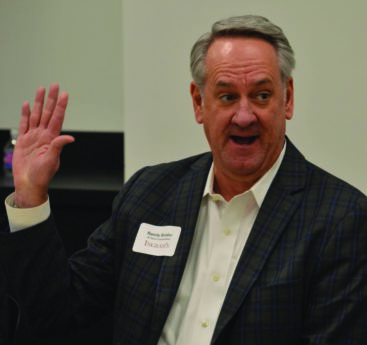
At times in a competitive bidding world, said Randy Bredar, construction companies “are our own worst enemies.”
That’s Jon Runyan’s experience, as well. “We have to be competitive, but there’s enough work so you can choose not just a better project, but a better project for you. Before, we looked at some projects we had no business looking at—that’s not the case now.”
Mary McNamara said that since 2012, “my labor costs are up 22 percent, but the price I charge out has gone up just 4 percent. I have had to be more productive and better organized.” The firm does commercial roofing, she said, but “in reality, I really sell labor.”
When downturns happen and bidding fever sets in, said Steve Hancock, “people will lose their minds, thinking ‘I need to be here’ on a bid. But the older I get, the more I think I don’t have to do anything. I’d rather float overhead than that, any day.”
During the last downturn, said Marsha Hoffman, “we saw people in our lane we’d never seen before. That undercut fees” and those still haven’t fully achieved pre-recessionary levels.
Most of the time, said Steve Levy, “it’s not the owner; we’re doing it to ourselves. When the market turns down, we do silly things. I’ve seen it too many times.”